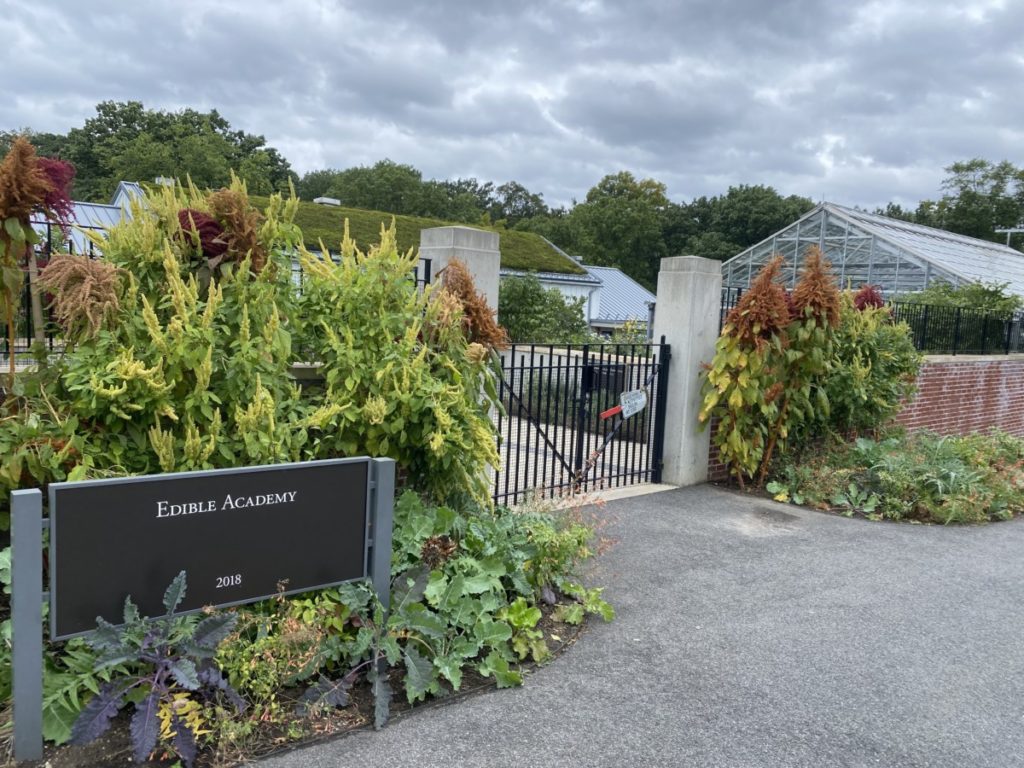
The “three sisters”— beans, corn, and squash—grow in a semicircle shaped plot at the far end of Edible Academy’s vegetable garden in the Bronx. Beans grow wrapped around corn stems for support. The roots of beans fortify the soil with nitrogen, important for the growth of corn and squash. Orange, yellow, and green squash have large sprawling leaves that cover the ground below the beans and corn, which keep the soil cool and moist and prevent weeds from growing.
“This companion planting technique was something that was taught to settlers by the Indigenous Americans,” said Edible Academy Educator Alyssa Markowski.
On Sunday, the same technique was taught to elementary-school-aged children during the Edible Academy’s event “Dig! Plant! Grow! The Three Sisters.”
Each child who participated was shown how to make a “Fiesta Corn Salad” out of the ingredients in the garden. Posters on small tables showed how beans might become soup, squash could be roasted and corn turned into spoonbread or fritters. Everyone was sent home with popcorn seeds to make into popcorn.
The Edible Academy’s garden, tucked away in the north-east corner of the New York Botanical Garden, is a small oasis in one of the most notoriously food insecure areas in the nation: the Bronx. NYBG is responding to this nutrition crisis through the new Edible Academy.

According to Hunger Free America’s most recent report, one in four Bronx residents experienced food insecurity between 2018 and 2020. The borough also has the highest level of food insecurity in all of New York City. Households with children were about 15 percent more likely to report having less income for food during the pandemic, according to the NYC Health Epi Data Brief.
“The pandemic has really highlighted the issue of food insecurity. Pre-pandemic rates of food insecurity were already unacceptably high for a country as wealthy as the United States,” said Kim Hekimian, a professor at Columbia University’s Institute of Human Nutrition.
During the pandemic, economic barriers to food grew—45 percent of residents reported less income and 20 percent were unable to buy groceries due to lack of money for food.
“Rates of food insecurity still remain higher than pre-pandemic,” said Professor Hekimian.
Hekimian explained that people who experience food insecurity tend to rely on low cost foods that are cheap and accessible. Those foods tend to be high in non-nutritive calories such as sugars, sodium, and other non-essential nutrients.
Figures from the Centers for Disease Control and Prevention showed that levels of childhood obesity surged to unprecedented levels during the pandemic. This is directly linked to inadequate nutrition.
The Edible Academy runs regular activities throughout the year to bring awareness to this issue.
“We have a program for school trip visits, summer camps, and scout groups,” said Ann Novak, the Edible Academy’s manager.
The most effective way to deal with the diseases caused by malnutrition is to prevent them from happening in the first place, Hekimian explained.
“It is important to teach children to grow food in an urban setting so that they are taught from a young age about fruit and vegetable intake, what dietary guidelines are and how to cook with these foods.”
